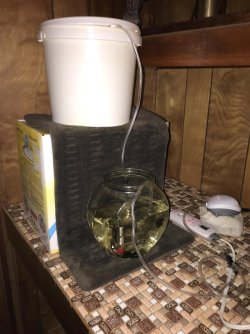And extra day in shipping can be a problem. Heat packs, if used, can run out. Ammoina and co2 build up during shipping.
I do not need to read the directions from your seller. I would not follow them anyway. Most fish cannot be acclimated to anything in a matter of hours or even days. it actually can take a couple of weeks for acclimation to occur. If you tak to peole who import fish, most will tell you the best thing to do when they arrive is to plop and drop. that mean out of the bag and into the tank. Notrmally, that should be a quarantine tank.
I read a loy of research papers dealing with fish related issues. Quie often they start out by telling from where the fish weacquired and then mentions that they were acclimated for a few weeks or a month before the experiment began. Here is a perfect example (underlining is by me).
MATERIALS AND METHODS
Animals.
Zebrafish (Danio rerio) were purchased from a local pet supply store (PetsMart, Canada) and housed in two 40-liter aquaria in dechlorinated Hamilton tap water, which is considered moderately hard (Na+ 927 ± 16 μM, Ca2+ 946 ± 11 μM, Mg2+ 422 ± 17 μM, Cu2+ 2.1 ± 0.7 μg/l, pH 8.3), maintained at 28°C (hard water). The fish were allowed 1 wk to acclimate to the new tanks before experimentation.
And here is a part of the Abstract from that study:
Craig, P.M., Wood, C.M. and McClelland, G.B., 2007. Gill membrane remodeling with soft-water acclimation in zebrafish (Danio rerio).
Physiological genomics,
30(1), pp.53-60.
Abstract
Little is known regarding the ionoregulatory abilities of zebrafish exposed to soft water despite the popularity of this model organism for physiology and aquatic toxicology. We examined genomic and nongenomic changes to gills of zebrafish as they were progressively acclimated from moderately hard freshwater to typical soft water over 7 days and held in soft water for another 7 days. Gills were sampled daily and mRNA expression levels of gill Na+-K+-ATPase (NKA) α1a subunit, epithelium calcium channel (ECaC), carbonic anhydrase-1 and 2 (CA-1, CA-2), Na+/H+ exchanger (NHE-2), V-type proton (H+)-ATPase, and copper transport protein (CTR-1) were quantified by real-time PCR. Changes in enzyme activities of gill NKA were determined and protein levels of NKA and ECaC were quantified by Western blotting. Levels of mRNA for ECaC increased fourfold after day 6, with an associated increase in ECaC protein levels after 1 wk in soft water. CA-1 and CA-2 exhibited a 1.5- and 6-fold increase in gene expression on days 6 and 5, respectively. Likewise, there was a fivefold increase in NHE-2 expression after day 6. Surprisingly, CTR-1 mRNA showed a large transient increase (over threefold) on day 6, while H+-ATPase mRNA did not change.......
from
https://journals.physiology.org/doi/full/10.1152/physiolgenomics.00195.2006
Acclimation in terms of weeks not hours and no dripping just being there. And here is another example"
Chung, K.S. Critical thermal maxima and acclimation rate of the tropical guppy Poecilla reticulata.
Hydrobiologia 462, 253–257 (2001).
https://doi.org/10.1023/A:1013158904036
Abstract
Tropical guppies, Poecilia reticulata, collected from the canal of La Laguna Los Patos were acclimated over a four-week period at local water temperatures of 24–33 °C to determine their critical thermal maxima (CTM) and death points (DP), as criteria of thermal tolerance. In addition, individual thermal tolerance times at a lethal temperature of 38.5 °C were measured over 12 days for upward acclimation from 24 to 30 °C and over 16 days for downward acclimation from 30 to 24 °C to determine acclimation rate just before and after changing the acclimation temperatures. The CTM ranged from 38.95 to 40.61 °C and the average DP varied from 41.22 to 42.86 °C. Positive relationships were apparent between thermal tolerance and acclimation temperatures, and thus heat tolerance criteria (CTM and DP) were significantly different among acclimation temperatures. Individual heat tolerance times increased most rapidly during the first 6 hours of upward acclimation after transfer from 24 to 30 °C, continued to increase another 5 days and fluctuated after initial acclimation was completed. The heat tolerance times of fish transferred from 30 to 24 °C declined steadily over times, reaching a minimum at 14–16 days after transfer.
from
https://link.springer.com/article/10.1023/A:1013158904036
So science thinks of acclimation in a lot longer terms than most in the hobby think about. And the scientist actually have the equipment to measure it all in terms of physiological changes. And they are willing to euthanize fish to obtain the results in many cases.
Every time I read about people trying to acclimate fish in 30 minutes or a few hours my eyes start to spin. I know this to be the case for FW fish, I cannot say if it is similar for SW fish. They may need acclimation?


